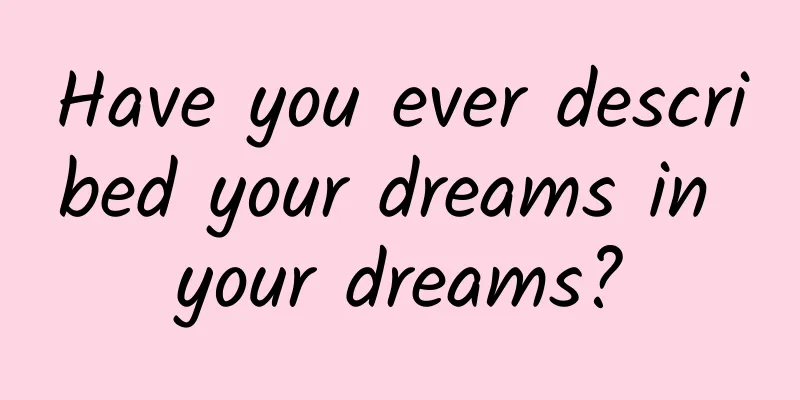Have you ever described your dreams in your dreams?

|
Leviathan Press: A friend taught me how to intervene in dreams in the early morning, that is, the rapid eye movement (REM) period when you are about to wake up: one is to drink more water before going to bed. Your bladder may not work before you wake up normally. At this time, you must remind yourself whether you have just dreamed when you get up at night. If so, you need to continue to remember it while going to the toilet until you return to bed. You can even think "Let me finish the dream just now." The second is to wake up with sound, such as setting an alarm clock, which sounds very similar to the kick-style wakeup in "Inception". Unfortunately, as a person who hardly dreams and easily forgets dreams, the urgent problem before me seems to be how to remember a dream... Studying dreams is fascinating, but also frustratingly difficult, expensive, and a bit frustrating. Famous psychologists like Sigmund Freud and Carl Jung may have made their names digging into the meaning and significance of dreams, but even today, with powerful brain-monitoring technology, it's still hard to figure out what's really going on in our dreams. If researchers have to wait to wake their subjects in the morning, they have to contend with "rapid forgetting." A better approach would be to wake people up while they're dreaming, but that requires a sleep lab and doesn't offer much advantage. Dreamers wake up groggy and are still prone to forgetting their dreams. If only you could communicate with people while they’re dreaming! Being able to ask dreamers to perform tasks, even if they’re simple at first (like counting backwards), could open the door to new insights. © Backyard Brains Opinions vary widely when it comes to understanding the function of dreams. Some theories suggest that dreams are meant to reinforce weak memory associations, others that they are meant to rehearse dangerous situations. Still others suggest that dreams have no function at all. Perhaps by communicating with dreamers, these theories could be better tested. But there are still many small issues that need to be resolved. As a scientist with a lot of imagination, many questions come to my mind. For example, what happens when you close your (non-existent) eyes in a dream? In real life, this cuts off light from the outside world; but in dreams there is no light, and the visuals of dreams come from your brain. What happens when the dreamer imagines an object appearing in front of them? When most people do this in a waking state, the imagined object is not as realistic as the real object. But in dreams, everything is your imagination. In a dream, does an imaginary object automatically appear as a real object? Or does it feel different from a real object even in a dream? How intense can pain be in a dream? Is it real pain? Dream characters are completely autonomous from the dreamer's perspective. Can people learn about themselves through conversations with dream characters? Dream characters are terrible at math, but sometimes they can come up with words the dreamer doesn't recognize. Researchers say the ideas dream characters come up with are sometimes more creative than the ones the dreamer comes up with when awake! If dream characters can access normally unconscious thoughts, dreamers could even try to converse with them for therapeutic, self-understanding purposes ("Why am I so afraid of the subway?"). Communicating with a dreamer presents an input and output problem. When dreaming, the input from our sensory organs is largely ignored. Therefore, if you talk to a sleeping person, they generally cannot hear you. The output problem is twofold. First, people usually don’t know they are dreaming. Dreams are the most convincing virtual reality we can experience, and even just trying to talk to someone outside of a dream is as incredible as trying to talk to someone outside of reality. Secondly, in dreams, when we try to do something that would normally move our body, our muscles don’t receive these instructions (this is called muscle atonia), and it’s our imagined dream avatar that actually moves. So even if we want to communicate, our gestures and sounds can’t be conveyed, just like people trapped in the “matrix” world of The Matrix. So how do dreamers communicate with people outside of dreams? © Psychology Today Psychologist Karen Konkoly and her colleagues are looking for a way to overcome these challenges and get more accurate information about the content of dreams, and they recently published a study in Current Biology that reveals a two-way communication method with dreamers. Four research teams around the world exploited several ways that information "bleeds" between dreams and the real world. On the input side, your sense organs are not completely cut off - if they were, it would be impossible for others to wake you up. What usually happens is that sometimes people feel loud noises, bright lights, or hard touches, and they often integrate into the dream story. You may have experienced this yourself, such as when your alarm clock goes off, your brain interprets it as a siren in the dream you are having. [In Christopher Nolan's "brain-burning" action movie "Inception", the protagonist relies on a strong "kick" to wake them up from their dreams. 】 On the output side, the dreamer has limited control over eye movements and facial muscles. That is, when the dreamer tries to move their arm, only the arm in the dream moves, but when they try to move their eyes, their physical eyes move with them. The scientists asked dreamers math problems, like "What's 8 minus 6?" One dozing participant answered correctly, "2": He moved his eyes to the right twice. In some cases, the researchers read the questions, and in others, they flashed a light or tapped the subjects. Over 158 attempts with 36 dreamers, the subjects got the answer right nearly a fifth of the time. Only 3 percent of the time were their answers completely wrong. Most of the time, they responded either cryptically or not at all. But given the challenges involved, any communication at all is noteworthy. This communication was possible in part because one group in the study knew they were dreaming. If you were asked "8 minus 6" by a booming voice out of nowhere, or if the question was coded to you by flickering lights in a room, you wouldn't usually think to respond by moving your eyeballs to the right twice. When dreaming, we accept what we are experiencing as real, even if its content is not realistic. But occasionally, people realize they are dreaming (and for some people, this is quite common). This awareness and understanding is called lucid dreaming. If you've ever experienced a lucid dream (and about 80% of people have at least one at some point in their lives), you probably remember how extraordinary it feels. People often report that dreams become more vivid—sometimes even more vivid than real life; lucid dreamers often wander into wild fantasies and adventure stories that feel very real. Rather than being influenced by their subconscious mind (which is often negative and anxiety-inducing), lucid dreamers live in an enchanted world, one they can consciously help shape. Many scientists were initially skeptical about the existence of lucid dreams, but Stanford psychologist Stephan La Berge used the fact that dreamers can move their eyes at will to prove that they can communicate while they are lucid. In Konkoy's study, researchers looked at normal sleepers, people who were already good at lucid dreaming, and non-lucid dreamers who were able to lucid dream after the researchers tried to train them. The researchers tried to get the non-lucid dreamers to answer math problems 379 times. They got the right answer once, an incorrect answer once, and 11 ambiguous answers. More than 360 times, the dreamers didn't respond at all. So, lucid dreams are the key to dream communication. Konkoy and her colleagues trained lucid dreamers to receive and send messages to prove that dreamers can remember and follow instructions they receive while awake, and can also perform cognitive tasks when asked. Interestingly, when the researchers woke their subjects and asked them about their dreams, the dreamers sometimes remembered math problems incorrectly, which is strong evidence that there are problems with dream reports given after people wake up and that they cannot be overly relied on. Even in lucid dreams, people's memories of their dreams can be wrong. A major obstacle to lucid dreaming research is that spontaneous lucid dreams are rare and difficult to master. Netflix's new film Behind Her Eyes, a British psychological thriller, features a lot of lucid dreaming, along with advice on how to have it—not all of which is reliable. We learn that staring at a clock or watch can help. That's true. But there's no research showing that counting your fingers helps. Trying to stay calm and focused doesn't help either. There's also an unfounded recommendation to imagine a door (if you suddenly enter a lucid dream state during a nightmare, imagining a door may help you escape, but this has not been scientifically studied). Acting out your fantasies in your sleep is one reason many people are so interested in lucid dreams. For those who are determined to learn about lucid dreams, the best place to start is with this systematic review published in 2012 in the journal Consciousness and Cognition (Stumbry, T., Erlacher, D., Schädlich, M., & Schredl M. Induction of lucid dreams: A systematic review of evidence. Conscious Cognition 21, 1456-1475). However, this review shows that most of the recommended self-help methods for lucid dreaming have not been scientifically studied, and the existing research is not very good. But here are a few methods that do have evidence (proven to work). It seems that when you fall asleep, you should visualize the dream you want to have and rehearse it. Set a goal in your mind that will make your brain aware that you are dreaming. This method is more effective in the morning, when you wake up and are about to fall asleep again. You may have used the technique of "dream re-entry" without realizing it. This is when you wake up from a dream and try to go back to the past without actually falling asleep. You can also get into the habit of testing reality—that is, practice reading text twice to see if it changes. In the real world, printed text, such as on a road sign, almost never changes. But in dreams, for whatever reason, text often changes. If you practice checking to see if text changes while you're awake, you'll probably do the same while you're dreaming. You'll then notice the text changing and enter a lucid dream state. Lucid dreaming is fun, but is it useful? Learning during lucid dreams is likely a far from fully developed activity. © The Sociable Just as practicing motor skills in your imagination can improve performance in more than 30 competitive sports, targeted lucid dreaming could do the same. The benefits may extend beyond improved physical performance. “Dreams may also provide a unique opportunity to mitigate the effects of emotional trauma,” Konkoy and her colleagues write, “thus, cues could be designed in advance to influence dream content or could be modified based on cues emitted by the dreamer during the dream.” Speaking to NPR, Conkoi said, "People often get an artistic, creative inspiration through lucid dreams or regular dreams. But in that dream state, the resources you have (to get inspiration) are only what you know in the dream." She thinks pairing a lucid person's more logical mind with that of a lucid dreamer might lead to interesting collaborative results—creative solutions to different problems, for example. But for most lucid dreamers, acting out fantasies is just a fun thing to do. Using eye movements to communicate with lucid dreamers is still a nascent science, and is susceptible to interference. Could future research lead to more powerful forms of communication, such as Morse code through the eyes? There was once a book written by someone who communicated through eyelid twitching, so I believe it can be done. We spend hours every night dreaming. It's a huge part of our lives. While the natural function of dreaming is still unclear, hacking our brains to participate in lucid dreams is a largely unexplored area of mental life. What happens when we harness these hours of creative, conscious experience? By Jim Davies Translated by Kushan Proofreading/Rabbit's Light Footsteps Original article/nautil.us/issue/98/mind/what-if-you-could-describe-your-dreams-while-dreaming This article is based on the Creative Commons License (BY-NC) and is published by Kushan on Leviathan The article only reflects the author's views and does not necessarily represent the position of Leviathan |
<<: What are the secrets of bees? What are the instincts of bees?
Recommend
World Parkinson’s Day: Don’t suffer from sleep disorders, let’s work together to create beautiful dreams!
Solve the sleep disorder problem of Parkinson'...
Will people who live according to the “latest research” live healthier lives?
With the accessibility of information channels to...
How to get out without the first time?
In fact, many girls have their first experience, ...
What home-cooked dishes are good for pregnant women?
Pregnant women must pay attention to dietary cond...
The labia minora is as white as if it had been blistered
We all know that for women, the vagina is very im...
Should I wear a belly band when sleeping at night?
For postpartum women, the part that is most likel...
How long does it take to get out of bed after a vaginal tear?
If a pregnant woman chooses a natural birth durin...
What causes breast tenderness before menstruation?
Many female friends will feel weak and have power...
Female sacrum picture
Sacral pain is a relatively common orthopedic dis...
The reasons for sagging breasts, let you know the real situation
There are many reasons why women's breasts be...
What are the reasons for a sudden decrease in menstrual flow?
In our daily lives, many people experience a sudd...
Is it a problem to have brown discharge in the third trimester of pregnancy?
It is very normal to have brown discharge from th...
Causes of missed menstruation
Women have more physical problems, which is proba...
In the cold winter, the natural resources industry talks about keeping warm and keeping healthy
The arrival of cold winter days throughout the ye...
How long does it take to get your period after hysteroscopy?
The surgery itself may have an impact on the endo...









